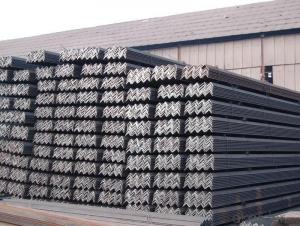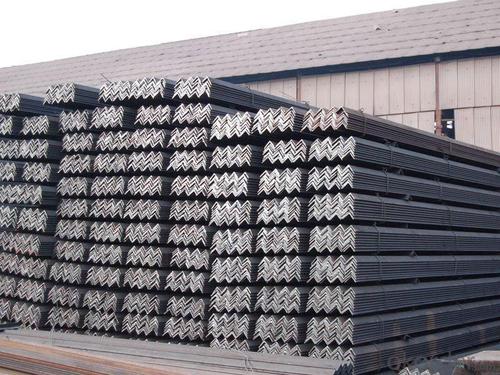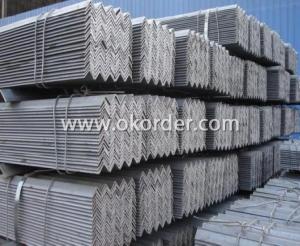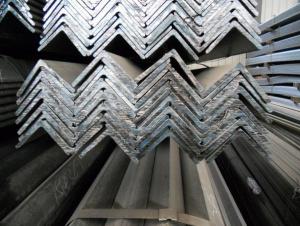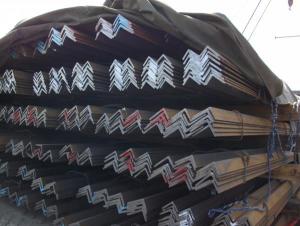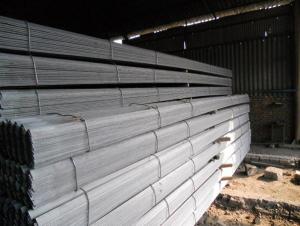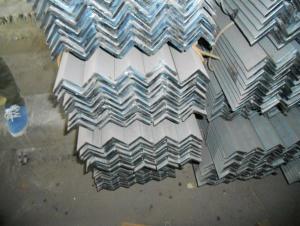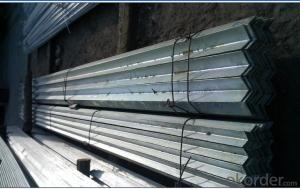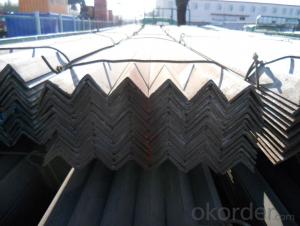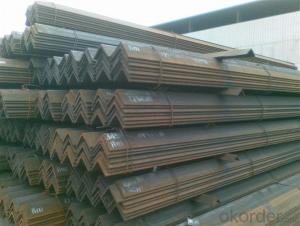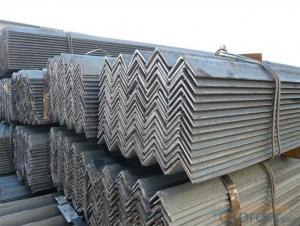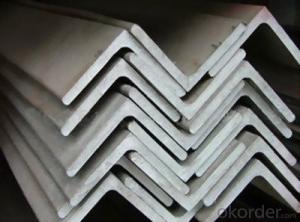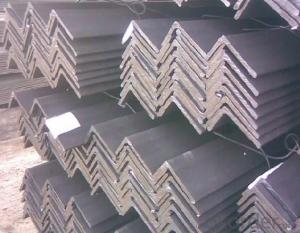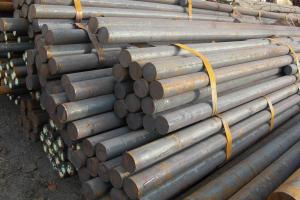Q345B Material High Quality Angle Bar
- Loading Port:
- Tianjin
- Payment Terms:
- TT or LC
- Min Order Qty:
- 25 m.t.
- Supply Capability:
- 2000 m.t./month
OKorder Service Pledge
OKorder Financial Service
You Might Also Like
Product Description:
OKorder is offering Angle Steel great prices with worldwide shipping. Our supplier is a world-class manufacturer of steel, with our products utilized the world over. OKorder annually supplies products to European, North American and Asian markets. We provide quotations within 24 hours of receiving an inquiry and guarantee competitive prices.
Product Applications:
According to the needs of different structures, Angle can compose to different force support component, and also can be the connections between components. It is widely used in various building structures and engineering structures such as roof beams, bridges, transmission towers, hoisting machinery and transport machinery, ships, industrial furnaces, reaction tower, container frame and warehouse etc.
Product Advantages:
OKorder's Angle Steelare durable, strong, and resist corrosion.
Main Product Features:
· Premium quality
· Prompt delivery & seaworthy packing (30 days after receiving deposit)
· Corrosion resistance
· Can be recycled and reused
· Mill test certification
· Professional Service
· Competitive pricing
Product Specifications:
1. Invoicing on theoretical weight or actual weight as customer request
2. Length: 6m, 9m, 12m as following table
3. Sizes
Sizes: 25mm-250mm | ||
a*t | ||
25*2.5-4.0 | 70*6.0-9.0 | 130*9.0-15 |
30*2.5-6.6 | 75*6.0-9.0 | 140*10-14 |
36*3.0-5.0 | 80*5.0-10 | 150*10-20 |
38*2.3-6.0 | 90*7.0-10 | 160*10-16 |
40*3.0-5.0 | 100*6.0-12 | 175*12-15 |
45*4.0-6.0 | 110*8.0-10 | 180*12-18 |
50*4.0-6.0 | 120*6.0-15 | 200*14-25 |
60*4.0-8.0 | 125*8.0-14 | 250*25 |
Alloy No | Grade | Element (%) | |||||
C | Mn | S | P | Si | |||
|
|
|
|
|
|
| |
Q235 | B | 0.12—0.20 | 0.3—0.7 | ≤0.045 | ≤0.045 | ≤0.3 | |
|
|
|
|
|
|
| |
Alloy No | Grade | Yielding strength point( Mpa) | |||||
Thickness (mm) | |||||||
≤16 | >16--40 | >40--60 | >60--100 | ||||
≥ | |||||||
|
|
|
|
|
| ||
Q235 | B | 235 | 225 | 215 | 205 | ||
Alloy No | Grade | Tensile strength (Mpa) | Elongation after fracture (%) | ||||
Thickness (mm) | |||||||
| ≤16 | >16--40 | >40--60 | >60--100 | |||
≥ | |||||||
|
|
|
|
|
|
| |
Q235 | B | 375--500 | 26 | 25 | 24 | 23 | |
Packaging & Delivery of Angle Bar
Packaging Detail: All goods are packed in bundle with steel strips and shipped by break bulk vessel or container (depend on target market and different ports)
Delivery Detail: 45 days
Trade terms: FOB, CFR, CIF
MOQ: 25 tons per specification; we can negotiate the quantity if the specification is normal or we have stock of one specification.
Weight: Theprice invoicing on theoretical weight basis or actual weight basis depends on customer’s request.
Shipment: The shipment of bulk break or container is depends on customer’s request and the situation of the port of destination.
Documents given: Full set of original clean on board bill of lading; Original signed commercial invoice; Original packing list; Policy of insurance; Certificate of origin and what the target market needs.
FAQ:
Q1 How soon can we receive the product after purchase?
A1 Within three days of placing an order, we will begin production. The specific shipping date is dependent upon international and government factors, but is typically 7 to 10 workdays.
Q2: How do we guarantee the quality of our products?
A2: We have established an advanced quality management system which conducts strict quality tests at every step, from raw materials to the final product. At the same time, we provide extensive follow-up service assurances as required.
Q3: How soon can we receive the product after purchase?
A3: Within three days of placing an order, we will begin production. The specific shipping date is dependent upon international and government factors, but is typically 7 to 10 workdays.
Q4: What makes stainless steel stainless?
A4: Stainless steel must contain at least 10.5 % chromium. It is this element that reacts with the oxygen in the air to form a complex chrome-oxide surface layer that is invisible but strong enough to prevent further oxygen from "staining" (rusting) the surface. Higher levels of chromium and the addition of other alloying elements such as nickel and molybdenum enhance this surface layer and improve the corrosion resistance of the stainless material.
Images:

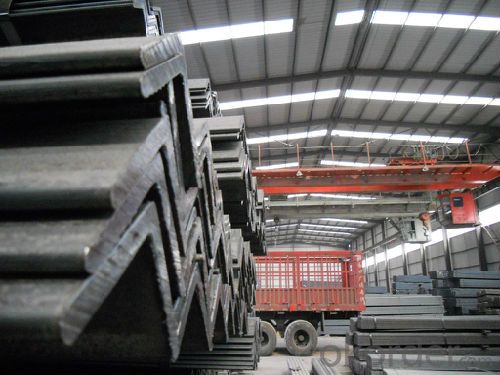
- Q: How do steel angles contribute to sustainable transportation infrastructure?
- There are several ways in which steel angles contribute to sustainable transportation infrastructure. To begin with, steel angles are essential in building bridges and highways. Their strength and durability make them perfect for supporting heavy loads and enduring the harsh conditions that transportation infrastructure faces. Consequently, structures constructed with steel angles have a longer lifespan, reducing the need for frequent repairs or replacements. This not only saves money but also lessens the environmental impact associated with the production and disposal of construction materials. Furthermore, the use of steel angles in the construction of transportation infrastructure allows for more efficient designs. Engineers can create innovative and lightweight structures with the versatility of steel angles, resulting in the requirement of less material overall. This leads to reduced energy consumption during the construction process and decreased emissions during transportation and installation. Moreover, steel angles are recyclable. They can be easily recycled and utilized to manufacture new steel products when they reach the end of their lifespan. This lessens the demand for raw materials and minimizes waste sent to landfills. The recycling process also requires less energy and emits fewer greenhouse gases compared to the production of new steel, making it an environmentally friendly choice. Additionally, steel angles can contribute to sustainable transportation infrastructure by facilitating the integration of sustainable technologies. They can support solar panels or wind turbines, enabling the generation of clean energy to power transportation systems. By incorporating renewable energy sources into infrastructure projects, the reliance on fossil fuels can be reduced, resulting in decreased greenhouse gas emissions and a more sustainable transportation system. In conclusion, steel angles have a crucial role to play in sustainable transportation infrastructure. Their strength, durability, recyclability, and ability to support sustainable technologies make them an environmentally friendly choice. By incorporating steel angles in the construction of bridges, highways, and other transportation structures, we can create a more sustainable and resilient transportation system that reduces the environmental impact and promotes a greener future.
- Q: What are the different grades of steel used in manufacturing steel angles?
- There are several different grades of steel that are commonly used in manufacturing steel angles. These grades vary in terms of their composition, strength, and other properties, and are selected based on the specific requirements of the application. One commonly used grade is mild steel, also known as low carbon steel or A36 steel. This grade is widely available and commonly used due to its affordability and ease of machining. Mild steel angles are often used in general construction and fabrication projects. Another grade is high-strength low-alloy steel (HSLA), which contains small amounts of alloying elements such as copper, phosphorus, niobium, or vanadium. HSLA steels offer higher strength and improved corrosion resistance compared to mild steel, making them suitable for structural applications in heavy machinery or marine environments. There are also higher-strength steels, such as high-strength steel angles (HSS) or ultra-high-strength steel angles (UHSS). These grades are specifically designed to provide exceptional strength and durability, often used in demanding applications such as bridges, high-rise buildings, or automotive components. Stainless steel is another common grade used in manufacturing steel angles. With its excellent corrosion resistance, stainless steel angles are commonly used in food processing, chemical, or marine applications where resistance to rust and staining is crucial. The specific grade of steel used in manufacturing steel angles depends on factors such as load-bearing requirements, corrosion resistance, and cost considerations. Consulting with a structural engineer or steel supplier can help determine the most suitable grade for a particular application.
- Q: How do you determine the required length of a steel angle for a specific application?
- In order to determine the necessary length of a steel angle for a particular application, several factors must be taken into consideration. 1. Load requirements: The first step is to calculate the maximum load that the angle will need to support. This includes the weight of the object or structure it will be holding, as well as any additional live loads like wind or snow. By determining the load requirement, you can determine the appropriate strength and size of the angle. 2. Structural analysis: Conduct a structural analysis of the intended application to determine the forces and stresses that will be applied to the steel angle. This analysis will help determine the necessary properties of the angle, such as its moment of inertia, section modulus, and bending capacity. 3. Material selection: Select the appropriate steel material for the application based on its mechanical properties, such as yield strength, tensile strength, and ductility. Different grades of steel offer varying levels of strength and durability, so it is important to choose the right material to ensure the angle can withstand the required loads. 4. Design codes and standards: Refer to relevant design codes and standards, such as those established by organizations like the American Institute of Steel Construction (AISC) or the Eurocode, to ensure compliance with industry regulations and guidelines. These codes provide specific formulas and procedures for calculating the required length and size of the angle based on the load and structural analysis. 5. Fabrication considerations: Take into account any limitations or constraints in the fabrication process that may affect the length of the steel angle. For instance, standard lengths of steel angles may be available, so it may be necessary to choose a length that is readily accessible or can be easily obtained through custom fabrication. 6. Consultation with professionals: If there are any uncertainties in determining the required length of a steel angle, it is recommended to seek advice from a structural engineer or a professional experienced in steel design. They can offer expert guidance and ensure that the angle is appropriately sized and designed for the specific application. By considering these factors and following a systematic approach, it is possible to determine the necessary length of a steel angle that fulfills the specific requirements of the application.
- Q: What are the different types of steel angles used in staircases?
- Staircases commonly employ various types of steel angles for different purposes. These angles are selected based on the specific needs of the staircase design. 1. The Equal Leg Angle, which forms a 90-degree angle with legs of equal length, is the most frequently used steel angle in staircases. It is typically utilized for structural support within the framework of the staircase. 2. Unequal Leg Angles, as the name implies, have legs of varying lengths. These angles are employed when one side of the staircase requires more support or when a desired aesthetic appearance is desired. They are commonly found in stair treads, risers, and stringers to enhance stability and strength. 3. L-Shaped Angles are utilized in corner connections of staircases. They consist of one straight leg and another leg perpendicular to it, forming an L shape. These angles are often used in stair handrails, balusters, and brackets to provide reinforcement and support at junctions. 4. Slotted Angles are designed with slots along their length, allowing for easy adjustment and flexibility in component positioning. They are frequently employed in adjustable stair brackets, tread supports, and other elements that may require fine-tuning during installation. 5. Flat Bar Angles, also referred to as flat stock angles, are created by bending flat steel bars to form a right angle. These angles are used to provide additional support and reinforcement in staircases that require extra strength. They are commonly found in heavy-duty stair applications or where increased load-bearing capacity is necessary. Ultimately, the appropriate choice of steel angle for a staircase depends on factors such as load capacity, structural requirements, aesthetic considerations, and the specific design of the staircase. Seeking guidance from a structural engineer or staircase designer can assist in determining the most suitable type of steel angle for a particular staircase project.
- Q: What are the different types of steel angles used in bridge construction?
- There are several types of steel angles commonly used in bridge construction. These angles play a crucial role in providing structural support and stability to the bridge. 1. Equal Leg Angles: Equal leg angles, also known as L-shaped angles, have two legs of equal length that form a 90-degree angle. These angles are used in bridge construction to provide support and reinforcement to the bridge components. 2. Unequal Leg Angles: Unequal leg angles, as the name suggests, have two legs of different lengths that form a 90-degree angle. These angles are commonly used in bridge construction to accommodate specific design requirements and support varying loads. 3. Bulb Angles: Bulb angles are special types of angles that have a bulb-shaped leg. These angles are used in bridge construction to provide additional strength and rigidity to the bridge structure, particularly in areas where high stress or heavy loads are anticipated. 4. Inverted Angles: Inverted angles are similar to equal leg angles, but the orientation is inverted, with the longer leg on the bottom. These angles are commonly used in bridge construction to provide additional support and stability, especially in situations where the bridge needs to withstand lateral forces. 5. Fillet Welded Angles: Fillet welded angles are angles that are joined together using fillet welds. These angles are used in bridge construction to create strong and durable connections between different bridge components, ensuring structural integrity and stability. Each type of steel angle has its unique properties and advantages, making them suitable for specific applications in bridge construction. The selection of the appropriate angle type depends on factors such as load requirements, span length, design specifications, and structural considerations. Professional engineers and designers carefully assess these factors to determine the best type of steel angle to be used in a specific bridge construction project.
- Q: Can steel angles be used for playground equipment?
- Yes, steel angles can be used for playground equipment. Steel angles are commonly used for constructing various playground structures such as slides, climbing frames, and swing sets due to their durability, strength, and ability to withstand heavy use and outdoor elements.
- Q: Can steel angles be used as support brackets?
- Indeed, support brackets can be fashioned from steel angles. In construction, steel angles find widespread usage in the provision of structural support and stability. They possess versatility and can be conveniently affixed to walls, floors, or alternative surfaces, thereby engendering a robust and dependable support framework. Frequently, steel angles are employed in supporting beams, joists, or shelves, and they can additionally serve as corner brackets to fortify joints or connections. The exceptional potency and resilience of steel render it an exemplary selection for support brackets, guaranteeing their ability to endure substantial loads and furnish enduring support.
- Q: How do you prevent steel angles from twisting?
- To prevent steel angles from twisting, various methods can be utilized: 1. Accurate fabrication techniques: Ensuring precise and accurate fabrication of steel angles is crucial. This involves making straight and square cuts to maintain the angles' structural integrity and prevent twisting. 2. Implementation of bracing and supports: During installation, it is important to use suitable bracing and supports to provide stability. Temporary supports, diagonal bracing, or cross bracing can be employed, depending on the specific application. 3. Utilization of proper welding techniques: When joining steel angles, employing appropriate welding techniques helps minimize distortion and twisting. This includes selecting the correct welding process, controlling heat effectively, and using suitable fixturing to hold the angles in place during welding. 4. Adoption of anchoring methods: Depending on the application, anchoring methods such as bolting, screwing, or welding the steel angles to other structural elements can prevent twisting. These methods enhance stability and prevent rotation or twisting when subjected to external forces. 5. Regular inspections and maintenance: Conducting frequent inspections is important to identify any signs of twisting or distortion in steel angles. If any issues are detected, immediate corrective action should be taken to rectify the problem and prevent further twisting. By combining accurate fabrication, proper bracing and supports, suitable welding techniques, anchoring methods, and regular maintenance, steel angles can be effectively prevented from twisting, ensuring their structural stability in the long run.
- Q: Can steel angles be used as reinforcements in masonry walls?
- Yes, steel angles can be used as reinforcements in masonry walls. Steel angles are commonly used to provide additional strength and stability to masonry structures. They are often embedded within the mortar joints or anchored into the masonry units to enhance the overall structural integrity of the wall. The steel angles help to distribute and resist the forces acting on the wall, such as lateral loads or bending moments, making them a reliable choice for reinforcement in masonry construction.
- Q: Can steel angles be used in agricultural applications?
- Yes, steel angles can be used in agricultural applications. They are commonly used in the construction of buildings, fences, and equipment in the agricultural industry due to their strength, durability, and versatility.
Send your message to us
Q345B Material High Quality Angle Bar
- Loading Port:
- Tianjin
- Payment Terms:
- TT or LC
- Min Order Qty:
- 25 m.t.
- Supply Capability:
- 2000 m.t./month
OKorder Service Pledge
OKorder Financial Service
Similar products
Hot products
Hot Searches
Related keywords
